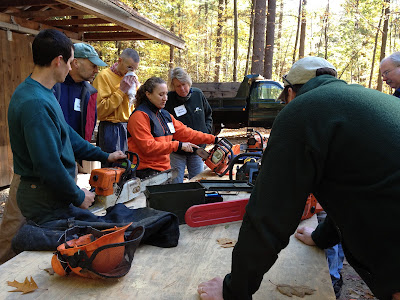Twice a year we offer a Chainsaw Safety and Maintenance Workshop at the Conservation Center in Concord. The course is designed to give participants instruction on how to operate a chainsaw safely in the woods. Land Stewards are required to take the class in order to use a saw on Forest Society property, so there is usually a good number of stewards or soon-to-be stewards in the class. This week's class was no exception. Of the 12 participants, 8 were land stewards with varying amounts of prior experience operating chainsaws. Forester Jake Bronnenberg of Bronnenberg Logging &Trucking, along with SPNHF Forester Wendy Weisiger, led the group through saw maintenance, safety gear, and proper felling and bucking techniques. Particpants practiced at each step, using their own saws when possible. Even long-time saw users generally learn some new tips at the workshop, and novices get a head-full of information to practice and remember the next time they start up their saw!
The Land Steward Program is a volunteer initiative run by the Society for the Protection of New Hampshire Forests (Forest Society). Land Steward volunteers receive comprehensive training and assist the Forest Society in managing 170+ forest reservations (>50,000 acres) across New Hampshire.
Friday, October 12, 2012
Chainsaw Time Again...
Twice a year we offer a Chainsaw Safety and Maintenance Workshop at the Conservation Center in Concord. The course is designed to give participants instruction on how to operate a chainsaw safely in the woods. Land Stewards are required to take the class in order to use a saw on Forest Society property, so there is usually a good number of stewards or soon-to-be stewards in the class. This week's class was no exception. Of the 12 participants, 8 were land stewards with varying amounts of prior experience operating chainsaws. Forester Jake Bronnenberg of Bronnenberg Logging &Trucking, along with SPNHF Forester Wendy Weisiger, led the group through saw maintenance, safety gear, and proper felling and bucking techniques. Particpants practiced at each step, using their own saws when possible. Even long-time saw users generally learn some new tips at the workshop, and novices get a head-full of information to practice and remember the next time they start up their saw!
Thursday, October 4, 2012
View Cutting by Memory at Hay Reservation
Well, the rain hasn't let up any since our soggy Trail Maintenance Workshop last week. Despite the bleary forecast, a group of hardy land stewards and staff headed out to the Hay Reservation in Newbury yesterday to work on the trails and expanding some of the views from the top of Sunset Hill. Luckily, most of us had been up to the top many times before and knew where the view was supposed to be, since it was so socked in that the only views were of were of gray masses of cloud. With fifteen workers, the job of expanding the (temporarily) imaginary view went quickly, and we had time to clean out a lot of silted in waterbars, brush out the trail corridor, and expand a view of Mt. Kearsarge (again, imagined, on that day) to the north from the Kidder Trail. It was a full day of trailwork by the time we were done, and we had to keep moving all the time or else risk getting seriously chilled in our waterlogged clothing. I, for one, know that as soon as I got home and had a hot shower and a hot meal, it was all I could do to keep my eyes open that evening! Looking forward to some photos of the improved views from Hay land stewards Bruce Barton, Bruce Healey and Tom Nowell once the skies dry out. I'll post them as soon as they arrive!
 |
| A quick lunch before we get chilled on the top of Sunset Hill |
 |
| Todd Wagner (left) and Bob Lyon (right) clear a view with loppers and hand saws |
Monday, October 1, 2012
Trail Maintenance & Design
 |
| Andrew Norkin (left) of AMC talks about sustainable trail design last Friday in Concord |
After a morning indoor session, the group of 25 participants braved the chilly rain and headed outdoors to look at some local examples of trail construction. Both good and poor examples were highlighted. As a final exercise, the group planned a mock "reroute" of an existing trail, flagging out a new route for an existing section of trail that would help shed water using grade dips and reversals. The shorter (less distance, and less time) and slower (less steep) that water runs on/down a trail, the fewer erosion problems will result! We didn't actually re-route the trail, but everyone gained a better understanding of how to lay out a sustainable natural surface trail. Thanks to the folks at AMC for a great workshop.
Subscribe to:
Comments (Atom)





